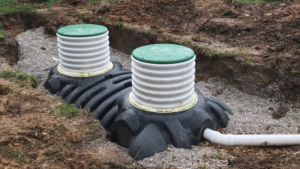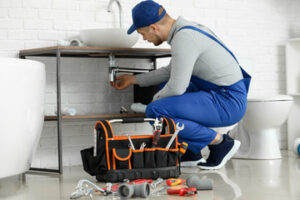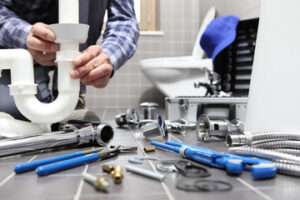A septic tank collects wastewater from your toilets, showers, sinks, garbage disposal, and washing machine. Microorganisms break down the solid waste, which sinks to the bottom of the buried container and forms sludge. Oil and grease floats to the top and forms a layer called scum. Click https://www.septictankarmadale.com.au/ to learn more. Compartments and the septic tank outlet prevent sludge and scum from leaving the tank with the liquid wastewater (effluent).
The liquid waste, or effluent, exits into a buried drain or leach field.

The absorption field is an area of uncompacted, unsaturated soil that receives and treats wastewater that exits the septic tank. The soil acts as a physical, chemical, and biological filter to purify the effluent before it reaches groundwater or surface water. Soils must be properly sized for the volume of wastewater so that they can easily absorb it without overloading and clogging the system.
If wastewater is not absorbed, it can enter groundwater, exposing people and pets to disease-causing organisms that contaminate the water supply. A contaminated water supply can also contaminate the home’s plumbing fixtures and surrounding landscape. A septic tank that fails to treat the waste properly can also pose a public health risk.
A septic tank is a buried, watertight container that holds household sewage long enough to separate the solids from the liquid. The solids settle to the bottom, forming sludge, while oil and grease float to the top, forming scum. A T-shaped outlet prevents sludge and scum from leaving the tank and traveling into the drainfield area. Liquid wastewater (effluent) exits the septic tank through the watertight, 4-inch-diameter pipe leading to the absorption field.
An undersized or poorly constructed absorption field is a common cause of failure. The size of the absorption field is based on the number of bedrooms in the house and the soil’s ability to absorb and retain wastewater.
Place a wood board or stick down into the septic tank to determine sludge depth and mark where it comes to rest. Next, push the board or stick into the sludge until you feel resistance and mark again. The difference between the two marks indicates the maximum sludge depth.
Before the septic tank can function properly, the soil in the absorption field must be able to accept and process wastewater without overloading or clogging the system. The soil must also be able to percolate water at a rate equal to or faster than the household sewage load.
Before constructing a new septic tank or absorption field, four perc holes are dug at the proposed site to determine the soil’s percolation rate. The slowest rate is used to size the absorption field, which must be at least 300 square feet per bedroom of the house for a conventional septic system.
Seepage Pit
A septic tank is a watertight container that holds wastewater long enough for solid waste to settle. When the liquid wastewater, also called effluent, exits the tank, it flows through a drainfield where microorganisms further treat it. The septic tank is usually made of concrete, fiberglass or polyethylene, and it has compartments for different types of waste. Solids, such as fats, oils and greases, sink to the bottom of the septic tank and form a layer known as sludge. The liquid wastewater floats to the top and is commonly called scum. Microorganisms break down these layers to form the clean wastewater.
Once the septic system is fully treated, the effluent seeps into the soil through the absorption field, returning to the natural water and weather cycles. This process is environmentally friendly and reduces the risks of sewage contamination for everyone who lives or visits your property.
It is essential to maintain proper maintenance on a septic system to extend its lifespan and prevent problems such as clogs or leaks. The septic tank needs to be pumped regularly, and you should make sure that all household products are safe for your septic system. This includes items like dental floss, paper towels, pet litter and bleach, which can all cause clogs. In addition, it is important to not park vehicles or construction equipment over the absorption field and other septic system components.
If you are considering buying a home that has a septic system, you should request that the seller provide you with a septic inspection report. Having this information will help you determine whether the system is in good working condition and can be maintained adequately for its intended lifespan. You may also want to consider submitting a contingent offer on the home, which is an offer that is dependent on passing septic inspections.
If you have questions about septic systems or need to schedule a service, contact Precision Excavating Inc. Our team is licensed by the Board of Health in Westchester and Putnam, NY to install and repair septic systems. We follow all local regulations to ensure that your septic system is operating properly. Call today to set up an appointment.
Inlet and Outlet Tees
Septic tanks are large underground containers designed to hold raw sewage for a specific duration. They have baffle walls that expertly segregate and direct the flow of wastewater to allow solid waste to settle and liquid effluent to exit. The inlet and outlet tees are critical parts of this process and are vitally important to the health and safety of your septic system.
When wastewater enters a septic tank it first hits the inlet baffle. This slows the flow and prevents scum from collecting and blocking the inlet pipe. The inlet baffle also helps to reduce the movement of gases from the septic tank back into the home or business it serves.
Once the septic tank contents have been treated the liquid effluent exits through the outlet pipe. This is a very important point and if it is not done correctly it can cause severe problems for the absorption field. The outlet pipe should extend at least 2 or 3 inches deeper than the top of the inlet tee. This is to prevent septic tank scum and sewage from running out the tank outlet and clogging up the absorption system or drainfield.
The outlet pipe should also be fitted with a sanitary tee. This tee is designed to regulate the opening of the tank so that solid waste, grease and other trash can not enter the absorption field. If the sanitary tee becomes blocked, a blockage in the septic tank or if the tee is missing altogether it could allow solid waste, grease and trash to enter the drain field and damage it.
If the inlet or outlet tee is damaged, it should be repaired immediately. This will help prevent odors and possible contamination of the absorption field or the surrounding property. It is also a good idea to have the tees checked and replaced as necessary at routine septic tank pumping.
This photograph by architect Waters shows the replacement tee parts used to repair this septic tank inlet baffle. He used a 22 degree elbow rather than a straight connection on the new tee to avoid bringing it too high up in the tank. It is important to have the tee fittings in the septic tank slope upwards so that incoming wastewater can not enter the tank and cause a buildup of sludge.
Pumps
Depending on how much you and your family use the septic system, you may need to have the tank pumped every three to five years. A septic system that is not properly maintained can lead to problems including clogs and backups in the drain field and contamination of groundwater. Pumping the septic tank removes solid waste that settles to the bottom of the tank, which prevents this material from entering the drainfield. This can minimize clogs and backups in the home and protects the absorption field from contamination by raw sewage.
A septic tank typically contains a series of pumps that control the flow of wastewater through the system. The system can be connected to a sewer system in some cases. The septic tank also contains a large lid with inspection ports that are used for access and cleaning of the septic system components.
The septic tank includes a series of float switches that control the operation of the pump. The lower float is the “pump enable/off” float. When this float tips to the up position it enables the pump to run. When the upper and middle floats tip to the down position, the pump stops running.
The wastewater that enters the septic tank is separated into liquid effluent and solid sludge. The liquid effluent is allowed to exit the septic tank through a large, central service hole. The sludge layer slowly builds up in the tank over time until it reaches the level of the outlet hole. When the sludge layer reaches this point, it must be pumped out by a licensed septic contractor.
Having a septic system installed in your home is the best way to protect the health and safety of your family. However, the septic system will not work without proper maintenance and regular pumping. It is also important to avoid flushing anything other than toilet paper and human waste. Items such as hair, grease and foreign objects can clog the system and cause a backup in the drain field or home.
Septic tanks should be mapped out so that system components can easily be located and accessed. This will help to prevent damage during home renovations, yard work and vehicle and equipment use. It is also recommended to keep shrubs, trees and other long-rooted plants away from the absorption field as they can grow into and clog pipes.

